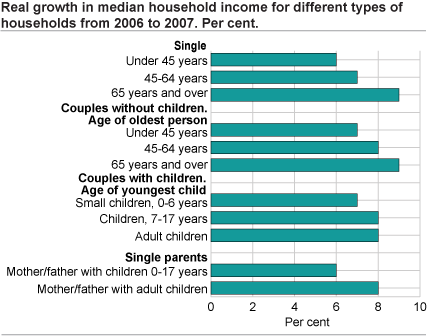Content
Published:
This is an archived release.
Strongest income growth for elderly households
All households had a strong increase in household income from 2006 to 2007. The elderly and the more established groups of households, however, had the strongest growth.
The households with the strongest increase in income are old-age pensioners, both singles and couples. They had an increase in median after-tax-income of 9 per cent from 2006 to 2007. Couples and singles at the age of 45-64 also had a larger income growth compared with younger couples and singles. For households with children, those with older children enjoyed a stronger rise in household income than households with younger children. Couples with children where the age of the youngest child is 7-17 years had an income growth by almost 8 per cent, while couples with younger children increased their incomes by 7 per cent. The median after-tax income for all households increased by almost 7 per cent from 2006 to 2007. The increase in household incomes can be explained by a strong growth in employment income.
Tables:
- Table 1 Income account for residents at current kroner. 1993-2007. NOK million
- Table 2 Income account for households, by type of household. Average per household. 2007. NOK
- Table 3 After tax income for households, by type of household 1990-2007. At constant prices. 1990 = 100
- Table 4 Number of household, by size of total income of the household. 2007
Contact
-
Jon Epland
E-mail: jon.epland@ssb.no
tel.: (+47) 92 61 69 08
-
Elisabeth Løyland Omholt
E-mail: elisabeth.omholt@ssb.no
tel.: (+47) 93 05 55 28
-
Christian Brovold
E-mail: christian.brovold@ssb.no
tel.: (+47) 91 75 31 32
-
Lene Sandvik
E-mail: lene.sandvik@ssb.no
tel.: (+47) 90 13 16 16

